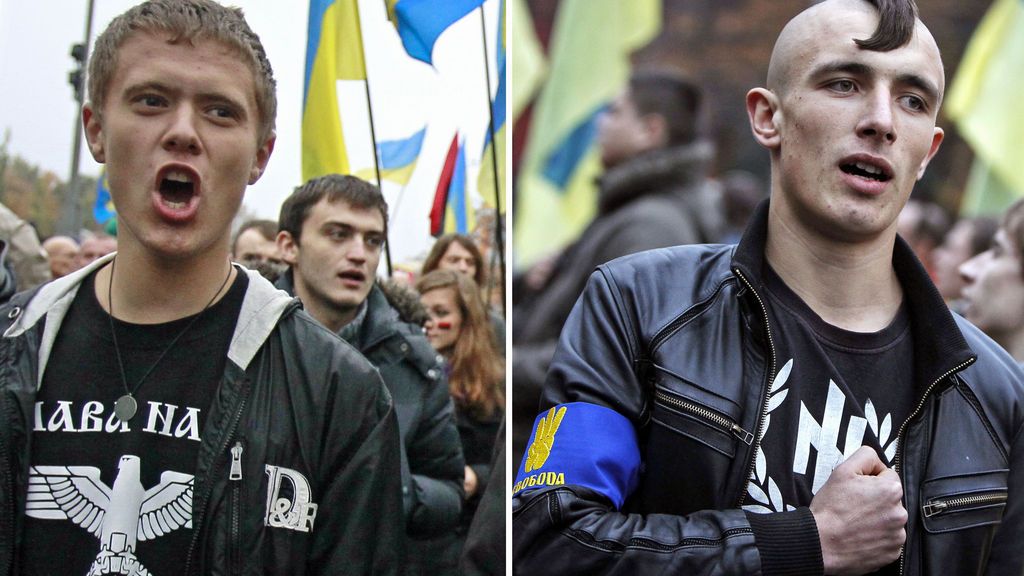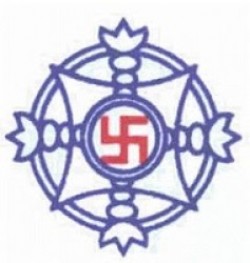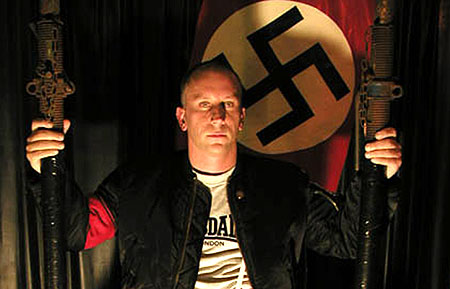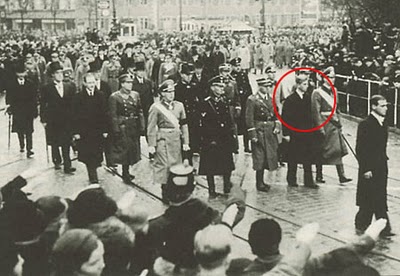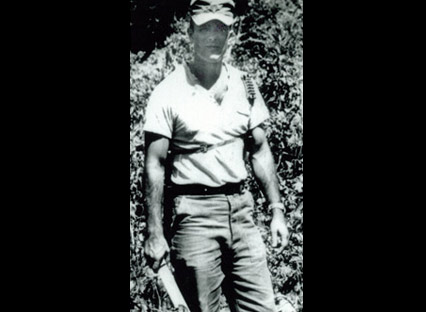Alex Constantine - October 5, 2010
By James Bargent
Toward Freedom | October 5, 2010
 Among the thousands gathered in New York for the protest against the “Ground Zero Mosque”, one small contingent stood behind a red cross on a white background - the St George’s Cross of England. The flag was adorned with a Stars and Stripes in one corner and the Israeli Star of David in the other. The letters EDL were stitched across the front. The group had flown to New York to represent Britain’s latest and fastest growing far-right movement – the English Defense League.
Among the thousands gathered in New York for the protest against the “Ground Zero Mosque”, one small contingent stood behind a red cross on a white background - the St George’s Cross of England. The flag was adorned with a Stars and Stripes in one corner and the Israeli Star of David in the other. The letters EDL were stitched across the front. The group had flown to New York to represent Britain’s latest and fastest growing far-right movement – the English Defense League.
The group is already well known in the US among readers of the high profile right-wing blogs Atlas Shrugs by Pamela Geller and Jihad Watch by Robert Spencer, where supportive reports of their activities frequently appear. Both writers are principal organizers in Stop the Islamization of America (SOIA), the campaign behind the protests against the planned Islamic community center near Ground Zero.
The EDL’s presence at the New York protest was part of its recently declared “new phase of international outreach and networking". The strategy has also seen them establish links across Europe, speaking at “counter jihad” conferences and courting renowned Dutch far-right politician Geert Wilders and his Party for Freedom. In doing so, the group is trying to tap into a rising fear and prejudice focused on Muslims that stretches from the Qur’an burning in the US to the banning of minarets in Switzerland and the electoral success of anti-Islam political parties in liberal bastions Sweden and the Netherlands. However, unlike Islamaphobic but non-violent movements like the Tea Party and its allies in the US and the populist political parties in Europe, the EDL was created in the mold of a far-right street army - a movement dedicated to aggressive mass-demonstrations and violent confrontation.
Over the last year, thousands have marched through cities across Britain in EDL demonstrations, ostensibly against “militant Islam”. Most of these protests have ended in violence directed against the police, anti-fascist protestors or the local Asian community - predominantly of Pakistani, Indian and Bangladeshi descent. Shaven heads, T-Shirts bearing the red on white of the St George's Cross and football chants - this is the English Defense League on the march. Visiting towns with a large ethnic minority population, they are corralled by police outside railway stations or on disused building sites. They chant “Allah, Allah – who the fuck is Allah?” or “Muhammad is a paedo” in a style instantly recognizable from the UK’s football terraces. Despite creating numerous headlines since their arrival on the political scene last year, supporters, opponents and the media have all struggled to define the EDL phenomenon.
 The origins of the league are to be found in a standoff in Luton, (a mid-sized town to the north of London) in April 2009. UK troops returning from Iraq were greeted by a handful of Muslim protestors with the slogan "Butchers of Basra". This provoked an immediate reaction from the crowd - while in the UK it is permissible to criticize the war, the soldiers - 'Our Boys' - are deemed beyond reproach. In the aftermath of the scuffles that followed, a nucleus formed around football hooligan 'firm' Casuals United and the tiny pressure group Stop the Islamization of Europe (SIOE).
The origins of the league are to be found in a standoff in Luton, (a mid-sized town to the north of London) in April 2009. UK troops returning from Iraq were greeted by a handful of Muslim protestors with the slogan "Butchers of Basra". This provoked an immediate reaction from the crowd - while in the UK it is permissible to criticize the war, the soldiers - 'Our Boys' - are deemed beyond reproach. In the aftermath of the scuffles that followed, a nucleus formed around football hooligan 'firm' Casuals United and the tiny pressure group Stop the Islamization of Europe (SIOE).
The group had an inauspicious beginning. Two separate rallies in Birmingham, a major city with a large Muslim population, ended in ignominious defeat as the EDL were chased through the streets by local youths. An attempt to protest outside a mosque in Harrow, London on September 11th 2009 saw only a handful of leaguers turn up. They were quickly confined to a pub for their own safety.
However, crucially, the EDL were able to portray these defeats as martyrdoms. A month later, the dominant image in publicity for the next march in Manchester was of a Union Jack being seized from a middle-aged white man by a gang of Asian youths. It was perhaps this imagery, together with an understanding of how to use social networking media to mobilize support that led to a much-increased turnout. With the mosques appealing to the young Muslim men not to go out to confront them, for the first time in October 2009 the EDL numbers matched those of the opposition.
From this point onwards the EDL seemed to be in the rise. At least once a month they would descend on towns and cities throughout the country: Manchester, Aylesbury, Nottingham, Newcastle, Stoke and elsewhere. The locations for these demonstrations were not usually chosen for their proximity to radical mosques or preachers. Instead they were placed provocatively in the centre of towns with large ethnic minority populations and often with a history of racial tension.
Whenever the EDL appeared it almost invariably led to violence. In Dudley and Stoke, supporters broke through police lines, tearing down the crowd-control barriers and perimeter fencing. They then rampaged through the towns’ Asian areas, smashing shops, homes and cars and, in Dudley, attacking a Hindu temple.
Every major protest was met by a counter-demonstration by locals and anti-fascists. The largest of these have been led by socialist group Unite Against Fascism (UAF), who have themselves become targets of the EDL. Confrontation between the groups is common and prominent UAF leaders have been victims of hate campaigns.
Journalists covering EDL demonstrations have also found themselves targeted, both at the demonstrations and through emailed threats. Jason Parkinson has regularly filmed the EDL since the first rallies in Birmingham. He has been attacked at protests and received threats afterwards. He said: “If the UAF’s there, they go for the UAF. If the UAF isn’t there they try to break through police lines and head towards a Muslim area. And if they can’t do that, they attack whatever is in front of them, which includes the press.”
Although the set-piece demonstrations remained the EDL’s main tactic, freelance groups began leaving pig’s heads outside mosques and turning up to small left-wing meetings to intimidate activists.
For a while the EDL looked as if they were on a trajectory of exponential growth. The opposition was being outnumbered. Then came Bradford – a run-down industrial town in the North with a large Muslim population. Bradford saw some of the UK mainland’s worst rioting in 2003 when a small demonstration by the National Front, a now largely defunct right wing street movement, sparked three days of upheaval. Nearly two hundred men, predominantly Muslim, were sentenced to prison in the aftermath.
In a deliberately provocative move, the EDL promised to bring 5,000 demonstrators to the city. One flyer bore the legend “Burn, Baby, Burn”. On the day, only around 700 supporters showed up and they were confined by police to a fenced-off strip of wasteland. Those that did break out from behind the lines of police were attacked by locals and anti-fascists and forced back into their pen. Many of Bradford’s Muslim youth had clearly ignored the exhortations of their elders and come out onto the streets to defend their city.
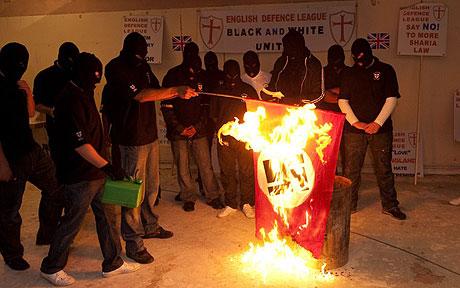 Members of the English Defence League in Luton Photo: DALE CHERRY
Members of the English Defence League in Luton Photo: DALE CHERRY
This defeat clearly shook the EDL and has lead to acrimonious finger pointing on the EDL’s web forums. The leadership attempted to blame violence at the demonstration on infiltration by the openly Hitler–worshipping group, Combat 18, while large numbers of the EDL’s rank and file voiced their frustration with the confined and controlled nature of the demonstration and even began accusing the leadership of stealing group funds.
The EDL’s rise to prominence has been so swift that it was not until Bradford that the fissures and inconsistencies in the movement began to surface. The organization’s insistence that it is a non-racist movement focused entirely on ‘Muslim extremism’ has forced it to adopt a ‘welcome one, welcome all’ policy. As a result it is not a monolithic body but a loose coalition operating on the basis of a lowest common denominator - a belief in the need to prevent the victory of Sharia law in the UK. However, despite small numbers of black and Asian supporters and the adoption of small LGBT, Jewish and even Anarchist divisions in the EDL, the movement remains effectively controlled and dominated by white men.
While some are die-hard neo-Nazis, many are football hooligans more interested in casual violence than white-supremacy. Others are disenchanted activists of the UK’s only significant far-right political party – the British National Party (BNP) - and there are even a diminishing number of law-abiding nationalists and ‘patriots’. While the leadership maintain that they have a very narrow focus on ‘Islamic militancy’, the rank and file are often simply there for the ‘muzzie-bashing’, and racist taunts about ‘Pakis’ are a regular feature of their mobilizations.
“Tom” – who does not want to be named – is an anti-fascist campaigner who has attended several EDL demonstrations. He said: “I’m sure there are some people who are confused and bought into the rhetoric. But I think there are far more people who are just there for a ruck (fight) and have been attracted to the movement because of the violence of their demos.”
Acutely aware of the failure of traditional far-right rhetoric to achieve a mass base, the EDL has instead tried to co-opt the language of liberals and progressives. On its website it states the organization is “a grass roots social movement who represent every walk of life, every race, every creed and every color”. They have even adopted the language of anti-fascist groups, using slogans such as “black and white unite” and calling opponents such as the UAF fascist for their “opposition” to free speech and democracy.
The clearest split between traditional far-right groups and the EDL is in its approach to Israel. Far from openly embracing the anti-Semitism and Zionist conspiracies of neo-Nazi groups, supporters frequently parade Israeli flags while the leadership has made Israel’s conflict with ‘Islamic terrorism’ a central part of its political philosophy. The recently formed EDL “Jewish Division” has protested alongside the Zionist Federation in counter-demonstrations targeting Palestine solidarity activists. However, the “Jewish Division” remains small and mainstream Jewish organizations have condemned the group and discouraged Jewish involvement. The Board of Deputies of British Jews described the organization as "built on a foundation of Islamaphobia and hatred which we reject entirely".
While it seems clear that on a street level the support for Israel is intended as little more than a provocation to Muslim communities, the leadership’s reasons for embracing the Israeli cause are little murkier. There can be little doubt that it has helped them court favor with the American right, where support for Israel is a prerequisite, while in the UK and Europe it supports their claims to be a multi-cultural organization and distances them from neo-Nazi groups that have no popular appeal.
Having seen the EDL in action, journalist Jason Parkinson is convinced that the commitment to Israel and claims of multi-culturalism are little more than a convenient front. He said: “If it got to the point where they got any more power or control then you would see the true element come through from the background, which is white, English, 100% Islamaphobic and certainly anti-Semitic.”
He added: “It works to say we’re multi-cultural, we’re not Nazis because we’re behind the Jewish state. But why are they behind the Jewish state? Because they blow up Muslims, that’s why.”
The EDL has gone to considerable lengths to distance itself from established far-right movements. Leader Stephen Yaxley-Lennon, aka “Tommy Robinson”, has referred to members of far-right groups that join EDL demonstrations as “fossils of fascism” and “Neanderthal Hitler worshippers”. The leadership has also aggressively denied links to the BNP. However, before Yaxley-Lennon became involved in the EDL he was, like a number of other key figures in the organization and many of its supporters, a member of the BNP. Well known neo-Nazis have also been filmed on demonstrations and been seen talking to organizers.
“Tom” described the EDL’s break with traditional far-right politics as “repackaged racism” He said: “The repackaging has tapped into something. They have seen what the mainstream media is doing in terms of scapegoating Islam and they have seen where they can gain popular support. The enemy has moved to Muslims rather than black people or Jews – not that the people involved aren’t anti-Semitic or racist but they have repackaged themselves and I think a lot of people have come to organized racism for the first time because of that.”
The success of the EDL in creating an alternative image has led to a confused response from the country’s dominant far-right group, the BNP. Initially, BNP leader Nick Griffin claimed the EDL was “a Zionist false flag operation, designed to create a real clash of civilizations right here on our streets between Islam and the rest of us.” However, in the wake of the EDL’s success, Griffin – infamous for calling the holocaust a "Holohoax" - has since switched his stance on Israel and turned the party’s focus to the Muslim world.
On a pre-election TV appearance earlier this year Griffin said: “There are Nazis in Britain and they loathe me because I have brought the British National Party from frankly an anti-Semitic and racist organization, into the only party which in the clashes between Israel and Gaza supported Israel’s right to deal with Hamas terrorists.”
The rhetoric of the EDL, now being imitated by the BNP, reflects a wider change in far-right politics and organization. From Geert Wilders to the Tea Party, the new far-right presents itself as a defender of liberal principles - freedom, democracy and even tolerance. But the thread that binds them to the Nazis and the KKK lies in the idea that there remains the need to protect ‘us’ from ‘them’. In Western European liberal democracies, the historic targets of far-right movements, Jews and blacks, are no longer so easily demonized in the popular imagination. Instead, an image of barbarian Muslim hordes is conjured up in their place. Playing on widespread fears of uncontrolled immigration and mistrust of Muslims following 9/11, these far-right groups, whether violent like the EDL, or political like Geert Wilders, have created a new ‘enemy within’ to threaten ‘our way of life’.
It is fertile ground. A poll of 32,000 British voters in last year’s European elections found 44% of Britons agreed with the statement: “Even in its milder forms, Islam is a serious danger to western civilization”. Only 32% disagreed. In Switzerland, the ban on the construction of minarets was passed by 57% of voters in a national referendum. In the Netherlands, Geert Wilders, who advocates a complete ban on the Qur’an – which he has compared to Mein Kampf – has seen his Party for Freedom grow from a political vehicle for his own career to the third largest party in the country and a member of the ruling coalition. In the US, the views of Glenn Beck, who has said: “In 10 years, Muslims and Arabs will be looking through a razor wire fence at the West” are considered mainstream.
For the EDL, the events of Bradford have left them at a crossroads. In the aftermath, the organization has been hit by a leadership struggle and divisions in the ranks over which direction to take. The contradictions of trying to balance a movement capitalizing on widespread popular prejudices to court respectability while drawing its strength from a street army intent on violence are placing a strain on the group’s unity. Frustrated with heavily policed and stewarded events, a sizeable section of EDL followers already seem to be adopting new tactics. In the weeks following Bradford there were a series of small, violent “flash mob” demonstrations, where small crowds descended with no advance warning. While numbers are dropping, violence seems to be increasing and many are worried about where it will end.
James Bargent is a freelance journalist based in the UK.
http://www.towardfreedom.com/home/europe/2131-right-turn-the-rise-and-violence-of-the-english-defense-league
